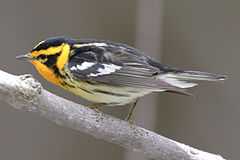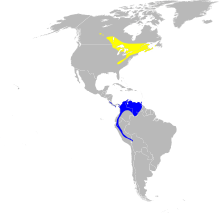Blackburnian Warbler
| Blackburnian Warbler | |
|---|---|
 | |
| In Rondeau Provincial Park, Ontario | |
| Conservation status | |
| Scientific classification | |
| Kingdom: | Animalia |
| Phylum: | Chordata |
| Class: | Aves |
| Order: | Passeriformes |
| Family: | Parulidae |
| Genus: | Setophaga |
| Species: | S. fusca |
| Binomial name | |
| Setophaga fusca (Müller, 1776) | |
 | |
| Range of S. fusca Breeding range Wintering range | |
| Synonyms | |
|
Dendroica blackburniae | |
The Blackburnian Warbler (Setophaga fusca) is a small New World warbler. They breed in eastern North America, from southern Canada, westwards to the southern Canadian Prairies, the Great Lakes region and New England, to North Carolina.
Blackburnian Warblers are migratory, wintering in southern Central America and in South America, and are very rare vagrants to western Europe. These birds were named after Anna Blackburne, an English botanist.
Description
 |
Song
A Blackburnian Warbler singing in the Porcupine Mountains, Michigan
|
| Problems playing this file? See media help. | |

Blackburnian Warblers are around 11 to 13 cm (4.3 to 5.1 in) long, with a 20 to 22 cm (7.9 to 8.7 in) wingspan, and weigh 8 to 13 g (0.28 to 0.46 oz). The average mass of an adult bird is 9.7 g (0.34 oz). Among standard measurements, the wing chord is 6.3 to 7.3 cm (2.5 to 2.9 in), the tail is 4.2 to 5 cm (1.7 to 2.0 in), the bill is 0.9 to 1 cm (0.35 to 0.39 in) and the tarsus is 1.6 to 1.8 cm (0.63 to 0.71 in).[2] In summer, male Blackburnian Warblers display dark gray backs and double white wing bars, with yellowish rumps and dark brown crowns. The underparts of these birds are white, and are tinged with yellow and streaked black. The head is strongly patterned in yellow and black, with a flaming-orange throat. It is the only North American warbler with this striking plumage. Other plumages, including the fall male and adult female, are washed-out versions of the summer male, and in particular lack the bright colors and strong head pattern. Basic plumages show weaker yellows and gray in place of black in the breeding male. Blackburnian Warblers' songs are a simple series of high swi notes, which often ascend in pitch. Their call is a high sip.
Ecology
Blackburnian Warblers are solitary during winter and highly territorial on their breeding grounds and do not mix with other passerine species outside of the migratory period. However, during migration, they often join local mixed foraging flocks of species such as chickadees, kinglets and nuthatches. These birds are basically insectivorous, but will include berries in their diets in wintertime. They usually forage by searching for insects or spiders in treetops. The breeding habitats of these birds are mature coniferous woodlands or mixed woodlands, especially ones containing spruce and hemlocks. It typically winters in tropical montane forests.
Blackburnian Warblers build a nest consisting of an open cup of twigs, bark, plant fibers, and rootlets held to branch with spider web and lined with lichens, moss, hair, and dead pine needles that's placed near the end of a branch. Three to five whitish eggs are laid its nest which is usually placed 2–38 m (6.6–124.7 ft) above the ground, on a horizontal branch.[3]
References
- ↑ BirdLife International (2012). "Dendroica fusca". IUCN Red List of Threatened Species. Version 2013.2. International Union for Conservation of Nature. Retrieved 26 November 2013.
- ↑ New World Warblers (Helm Field Guides) by Jon Curson. Christopher Helm Publishers (1993). 978-0713639322.
- ↑
- Curson, Quinn and Beadle,New World Warblers ISBN 0-7136-3932-6
- Stiles and Skutch, A guide to the birds of Costa Rica’’ ISBN 0-8014-9600-4
External links
| Wikimedia Commons has media related to Blackburnian Warbler. |
| Wikispecies has information related to: Setophaga fusca |
- Blackburnian Warbler videos, photos, and sounds at the Internet Bird Collection
- Blackburnian Warbler Species Profile - The Nature Conservancy
- Blackburnian Warbler Species Account - Cornell Lab of Ornithology
- Blackburnian Warbler - Dendroica fusca - USGS Patuxent Bird Identification InfoCenter
- Stamps (for Cuba, Grenada) with Range Map at bird-stamps.org
- Blackburnian Warbler photo gallery at VIREO (Drexel University)
